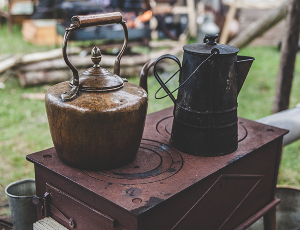Antiques and Restoration

What makes an object an antique?
What do you think of when you hear these terms?
- Antique
- Retro
- Vintage
Definitions
- Antique: 100 years old or more
- The term originally only referred to goods made before 1830, prior to mass production in the US
- Vintage: 50 years or more
- Retro: Refers to anything that imitates an older style, the item does not have to genuinely be from said time period.
How can you find information about antiques?
Museums
Just Answer Antiques
Just Answer
- Ask questions directly to antique dealers, lawyers, doctors, veterinarians, and other experts.
- $1 - $5 one week trial price, after which there is a $50 monthly fee.
- Cancel your membership after one week in order to avoid the larger fee.
- They can give you information on the cost, style, origin, and time period of your antiques.
Common Styles
- Rococo
- Victorian
- Arts & Crafts Movement / Mission
- Art Nouveau
- Art Deco
- Mid-century Modern
Antique Care
Storage, Cleaning, Restoration & Repair
Storage
Items in Use
- Keep antiques away from windows. Rotate items incrementally over time to reduce irregular sun fading. Curtains can help.
- Grandfather clocks are often the most sun-damaged antique.
- Cover surfaces with cloth to reduce scratches.
Items in Storage
- Cover with a sheet and keep items away from the window.
- Check on stored antiques at least once a year to monitor for termites and water damage.
- Stored wooden furniture still needs to be waxed once a year.
Cleaning
Cleaning Your Antiques
- Cleaning should be minimal. Cleaning too much will get rid of the patina and reduce the antique’s value.
- Patina: Thin layer that variously forms on the surface of copper, brass, bronze and similar metals, or certain stones, and wooden furniture, or any similar acquired change of a surface through age and exposure.
- Lightly wiping down surfaces with water, a rag, and a small amount of soap is the safest way to clean antiques. Other methods: vinegar, denatured alcohol
Dusting Your Antiques
- Dust with a soft wet rag.
- Wiping a surface with a dry rag will create micro-scratches.
- Some antique experts prefer to dust with feathers, but this method is contentious. Critics of this method worry that quills scratch wood.
Waxing Wooden Furniture
- Wood Furniture needs to be waxed 1 - 2 times per year. More than that can cause damage to your wooden furniture.
- Pure beeswax is preferable. A good commercially available wax is Howard Feed-N-Wax
Metal
- Silver: Polish
- Gold: Polish
- Brass/ Bronze/ Copper: Consider polishing, but probably leave the patina
- Iron: Wash with warm water, scrub with kerosene, polish with steel wool (+rust remover), rinse thoroughly, dry with a cloth.
- Steel: Prevent rust. Clean with vinegar and lime solution. Consider painting, powder coating, or re-surfacing steel that is seriously deteriorating,
Restoration vs Repair
Restoration is preferable to refinishing
Restor-A-Finish
Refinishing
- Chemicals for stripping wood can be harmful and refinishing will often reduce the value of antiques. People still choose to refinish if pieces are extremely damaged or if they have a strong aesthetic preference.
- Types of finishing: Wood Stain, Polyurethane, Lacquer, Shellac, Tung
Restoration
Furniture: Tighlman Chicago
SW Burbs
General Restoration: Evanstonia
6417 N Ravenswood Ave, Chicago, IL 60640
Rewiring: A Lamp and Fixture Corp.
3181 N Elston Ave, Chicago, IL 60618
